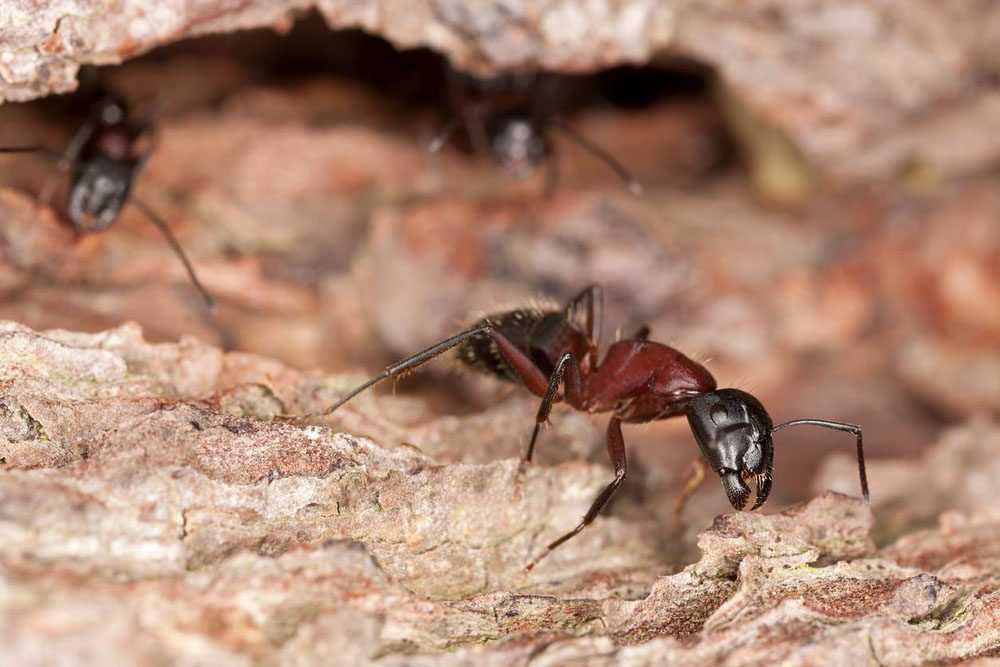Tell-Tale Signs of a Carpenter Ant Infestation – Signs and What to Do
Carpenter ants are large black or brown ants that can cause serious damage to a home’s wooden structure if allowed to thrive. Often the winged carpenter ant is mistaken for termites, which is also a serious problem here in the Northwest.
The Warning Signs of a Carpenter Ant Infestation: What to look for
Carpenter ants love to nest in dead or decaying wood. Wood that has been damaged by water is a special favorite here in Oregon and Washington for these ants. Sometimes carpenter ants will move into the structural wood of a home from a nearby nest. It’s a given that carpenter ants can cause serious damage to a home’s structure, but if you know what to look for there’s plenty of time to control the infestation in a proper manner and save your home from expensive problems.
Winged carpenter ants generally emerge from their nesting sites in the spring or early summer months. They can often be seen outside homes and in yards searching for new nesting sites. Seeing winged carpenter ants outside your home is no reason for alarm, if you begin finding them inside your homes during these months, you may have a carpenter ant infestation and should seek professional help quickly as this can be a sign of a 3 to 4 year old (or longer) infestation.
Another tell-tale sign of a carpenter ant infestation is the year around presence of wingless carpenter ants. They can often be found searching for food as they prefer animal and vegetable food sources. If you only find these ants at specific times of the year, the nest is probably located outdoors, near your home. It is important to trace these ants back to their nest, remove the dead or rotting wood and treat the nesting area to prevent them from moving into your home. Here in Oregon and Washington our abundance of trees and our generally wet climate make for a great combination for plentiful nesting sites for these ants.
Other warning signs that you may have a carpenter ant infestation include small piles of sawdust looking material in random areas of your home. Crawl spaces, corners, and dark areas are common places to find these piles of dust. In heavy infestations, you may even hear faint rustling noises in your walls.
Controlling and Eliminating a Carpenter Ant Infestation
The number one important step in eliminating a carpenter ant infestation is locating all nesting areas inside your home. Don’t make the mistake of thinking there is only one nest as many times there can be several nests, even in the same general area. A thorough check of your home inside and out, paying particular attention to any wood that is moisture damaged or decaying can help in finding the starting point of an infestation. Tapping wood suspected of being compromised by carpenter ants and listening for rustling noises is another way to identify nesting areas. The use of a stethoscope or a glass cup up to your ear can help in listening for movement in the wood. Hollow sounding wood is another give away of potential issues.
Completing a search around your homes yard can point to original nesting sites in dead or decaying trees, wood piles or outdoor structures. Treating these nests can help prevent re-infestation.
Preventing Carpenter Ant Infestations
Preventing carpenter ant infestations is the best defense in making sure your home doesn’t become victim to these common pests. Below we have listed a few common home fixes to prevent these ants from taking up residence in your home.
- Trim plants, trees and shrubs away from your home.
- If your home has water damaged or decaying wood, get it replaced.
- Fix any moisture problems in and outside of your home. Leaky roofs, gaps in siding, clogged or damaged gutters and plumbing problems are common areas to check.
- Remove any dead, or diseased trees from around your home. It’s usually a good idea to have a 60 foot radius of dead free trees and branches.
- Firewood and other wood piles should be stored away from your home.
- Maintain continuous protection around your home through our regular pest control treatments.
If you’ve identified a carpenter ant infestation, call PURCOR today to get a free quote.
"*" indicates required fields
"*" indicates required fields




